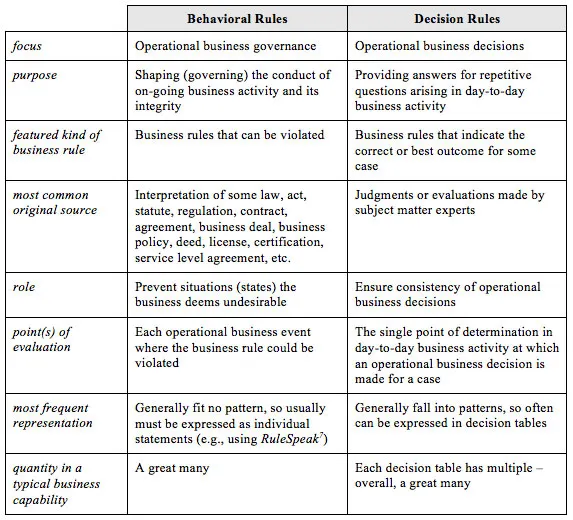What Is A Business Rules Management System (BRMS)?
Blog: ProcessMaker Blog
Organizations that seek to improve their workflows through exciting new technology like automation need to first achieve a level of formality in their policies and decision-making processes. This is where business rules and a system for defining, implementing, and managing them come into play. That system is known as a business rules management system (BRMS). In this guide to BRMS we will cover:
- What are business rules?
- What is a business rules management system (BRMS)?
- Key components of a business rules management system
- Benefits of a BRMS
- How BRMS can be used alongside BPM
What are business rules?
Business rules are directives that define and/or constrain an organization’s business activities. Business rules are important because they specify an organization’s objectives and provide guidelines on how processes will be performed. Many organizations have informal and undocumented business rules. In these organizations, employees know what they are supposed to do and do it according to their ingrained understanding of their job functions.
Undocumented business rules, however, lead to inefficiencies and inconsistencies across an organization’s processes. Business rules management is a method for formally defining how an organization’s business processes are performed. With business rules management, business objectives and processes are known by all members of an organization. This allows organizations to scale their operations while providing employees with an efficient level of autonomy.

What is a business rules management system (BRMS)?
A business rules management system (BRMS) is a software solution that is used to define, deploy, execute, monitor, and manage business rules and decision logic. With a BRMS, business rules and decision-making are automated across an organization’s business processes. A BRMS can distinguish relationships between various business rules and associate rules with technological solutions that perform the required functions.
Business rules management systems have broad use scenarios across industries. Organizations that can benefit from a BRMS include:
- Any organization that is governed by a defined set of business rules and/or internal policies that impact stakeholders. A BRMS simplifies the decision-making process by taking into account all rules, regulations, and relevant considerations that an organization is subject to.
- Organizations looking to improve efficiency while making more informed decisions. For many organizations, particularly those that still rely on antiquated decision-making processes and business logic, making business decisions is a time-consuming process. With a BRMS, organizations utilize technological solutions like automation to improve the speed and accuracy of important decisions.
- Organizations that want to increase compliance while reducing the possibility of legal and regulatory actions. In industries like banking where there are significant regulatory obligations, a BRMS can simplify compliance through automation.
- Organizations desiring flexibility to adapt to changing market conditions and/or pivot to new business opportunities. It is more important than ever to adapt quickly and pivot to exploit new opportunities.
Key components of a business rules management system
There are many different types of business rules management systems, offering a wide variety of features and functionality. Every BRMS, however, includes the following key components:
Repository
A repository is a database infrastructure that collects, manages, and stores data. In a BRMS business rules are stored in a repository rather than embedding rules as code within the application. This way the rules can be accessed by more than one application and are available for reuse.
Development Environment
A BRMS provides development tools for both technical and business users to define and manage business rules. Users can develop business rules without writing code and validate business rules, among other features.
Runtime environment
A runtime environment is a hardware and software infrastructure that enables the operation of a codebase in real time. In a BRMS, this allows applications to invoke the applicable business rules and execute them using a business rules engine.
Benefits of a BRMS
A business rules management system offers organizations a broad range of benefits. Some of the key benefits include:
- Increased efficiency through automated decision-making, reducing the need for the manual processing of recurring decisions
- The ability to scale decision rules across multiple applications
- Ensure compliance with applicable policies and regulations. With a BRMS, policies and regulations are encapsulated within business rules ensuring automatic compliance and creating an audit trail.
- Improved customer service and superior customer experiences. BRMS can guide customer service agents through best practices and organizations can provide increased self-service functionality.
- Enhanced security features. Protects business rules from alteration, loss, or access by unauthorized individuals.
- Analyzing and improving decision logic. A BRMS helps organizations to identify areas where decision logic can be improved. In addition, decision logic can be expressed with precision using business vocabulary syntax and graphical rule representations.
How BRMS can be used alongside BPM
To understand how a BRMS can be used alongside a business process management (BPM) system, it helps to first understand the distinction between the two. We said above that a BRMS is a system for defining, executing, and managing business rules. A BPM system, however, is a software solution that helps organizations to optimize their business processes to increase efficiency and productivity.
Clearly defined business rules specify how, when, and by whom tasks are performed. With a BRMS, an organization can implement and manage business rules to form the foundation of efficient processes. Processes are then optimized using BPM, allowing organizations to improve productivity, reduce costs, and improve compliance.
ProcessMaker is a low-code business process management software that allows organizations to incorporate business rules management to ensure efficient, automated, and data-driven decision-making.
The post What Is A Business Rules Management System (BRMS)? appeared first on ProcessMaker.
